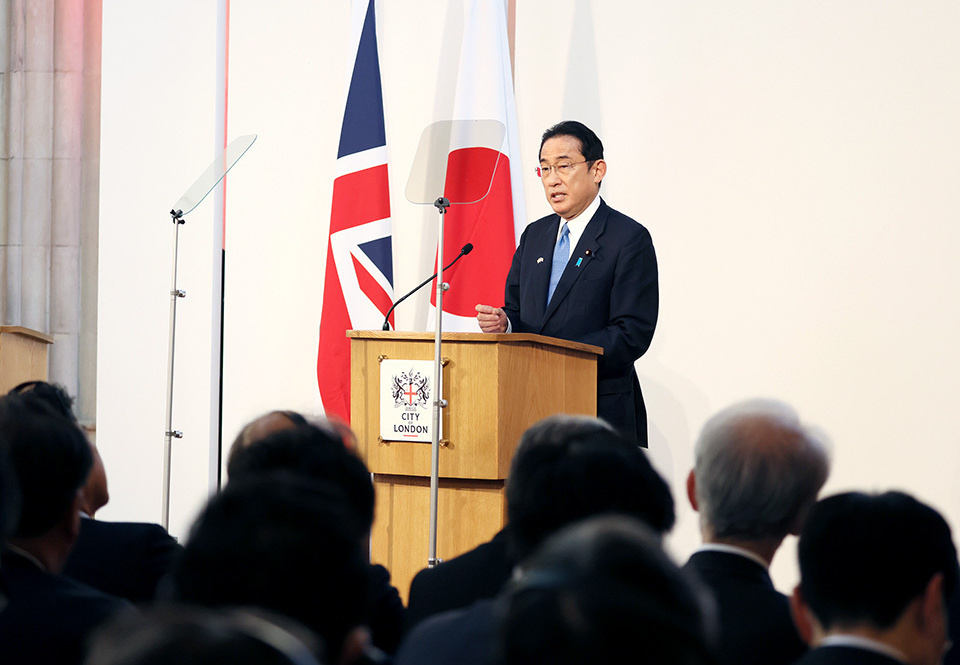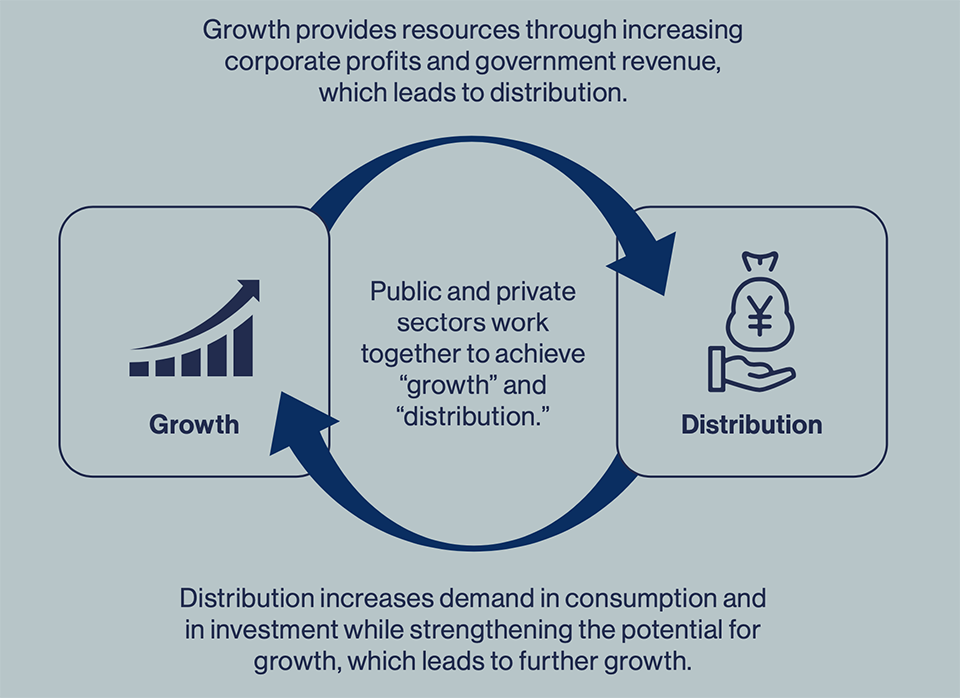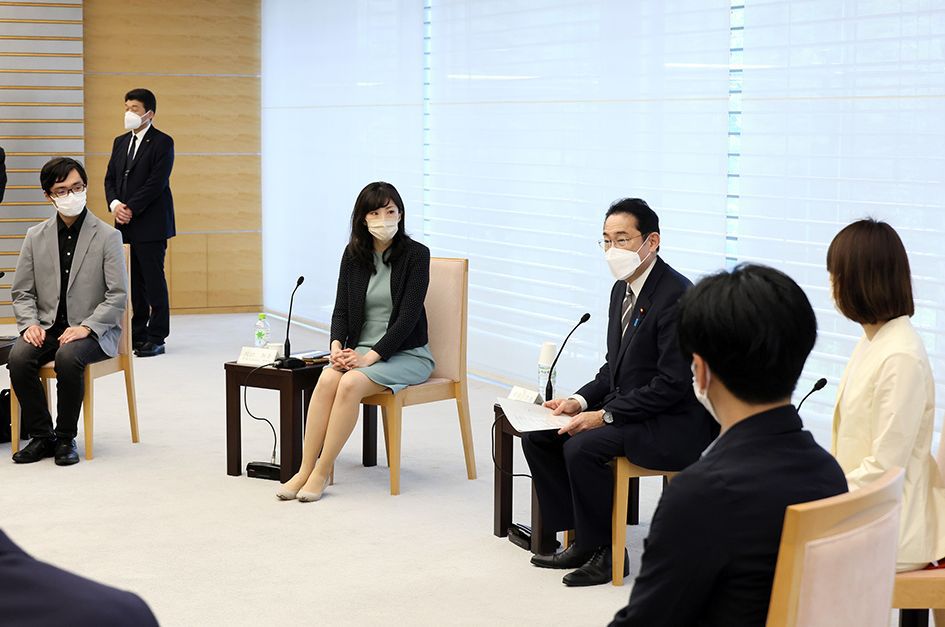MAY 5, 2022

Prime Minister Kishida giving his speech at the Guildhall in the City of London. After expressing his determination at the start of the speech to continue to take resolute action regarding Russia’s aggression against Ukraine, he described a new form of capitalism of his economic policy.
On May 5, Prime Minister Kishida gave a keynote speech to investors in the financial district of the City of London. Calling for the audience to “Invest in Kishida,” he explained the economic policy of his “new form of capitalism,” whose core concepts are a virtuous cycle of growth and distribution and the development of a new post-COVID-19 society.
I would like to introduce to you an economic policy I am advocating, which I call “new form of capitalism”.
The single message I wish to convey to you is this: The Japanese economy will continue to see robust growth. You can invest in Japan with confidence. Invest in Kishida.
Of course, Japan does face many challenges. But I am prepared to lead reform efforts to tackle these challenges head-on. One feature of the Japanese economy is stability. Because we live in an era of geopolitical uncertainty with supply chain disruptions and drastic shifts in energy and other resources, I see this as an advantage for Japan.
Sustained growth; stable markets; and safe, reliable companies, products and services. This is why Japan is a “buy.”
I am the first post-war Japanese Prime Minister with experience working in the finance industry. From 1982 to 1987, I worked for a bank that supported recovering businesses. As a staff member responsible for loans for the shipping industry, which was struggling with international competition, I witnessed a number of bankruptcies first-hand, but also worked with managers to promote corporate restructuring.
My strong conviction based on these experiences was that a robust economy supported by the animal spirits of the private sector is of paramount importance. Since I entered politics in 1993, I have worked on industrial policy, science and technology policy, and policies for small and medium-sized enterprises.
Based on my personal experiences, I would argue that I am the most knowledgeable recent Japanese prime minister when it comes to the realities of the economy and finance, and I will continue to advance policies by listening to the voice of markets as well as the people on the ground.
So let me be clear: Japan is and will continue to be a trading and investment powerhouse open to the world. Japan will grow by being connected to the rest of the world through the free movement of people, goods, money and digital technologies across borders.
We have now eased border control measures significantly, with the next easing taking place in June, when Japan will introduce a smoother entry process similar to that of other G7 members.
Japan is, and always will be open to the world. Distinguished guest, I earnestly hope that all of you will visit Japan. We will offer our utmost hospitality.
Now, let me say a few words about the “new form of capitalism” that I have been advocating. What exactly do I mean by “new”? To put it succinctly, I am talking about an upgrade—a stronger, more sustainable version of capitalism.
Why does capitalism need upgrading? Because we need to solve two crucial present-day challenges.
One is the problem of economic externalities, such as widening inequality, climate change and issues deriving from urbanization. Global capitalism has driven growth and prosperity, and its achievements should be duly acknowledged. But in its current form, it also has downsides.
The second pressing challenge is that posed by authoritarian states. Liberalism and democracy are under pressure from authoritarian regimes. We must make economies in democratic nations sustainable and inclusive in order to defend freedom and democracy.
Capitalism has changed before. Indeed, it has experienced at least two major transformations. One was the transition from laissez-faire to the welfare state. The other was the shift from the welfare state to neoliberalism.
In both of these transitions, the pendulum swung between two ideas: “market or state”, “public or private”. But the next transition will be to a “new form of capitalism”, in which the public and private sectors work together. Instead of “or,” we will have “and.”
Under this new form of capitalism, social challenges can become engines of growth. We will address social problems while at the same time driving robust growth. “Two birds with one stone,” as we say in Japanese as well as in English.

In Japan, there are a number of things we need to do to achieve a new form of capitalism: eliminate distribution blockages; overcome underinvestment in new value-added sectors; boost labour mobility to new sectors; promote diversity; and nurture what I would call a “healthy economic metabolism.”
Accomplishing these things will require investment, specifically in four key areas: people; science, technology and innovation; start-ups; and green and digital initiatives.
Let me start with people. Investment in human capital is at the heart of the growth strategy of the Kishida Administration.
Creativity and innovation will be crucial in the waves of digital transformation and decarbonization—and for that we need skilled people who can create and innovate. Japan will face labour shortages. We must produce maximum value with a shrinking pool of workers.
We need to expand investment in people, both in terms of “flow” and “stock.”
On the flow side, the relevant issue is wages. The government will introduce tax incentives that encourage employers to increase wages, and work with the private sector to create a social atmosphere in which it is normal and natural for pay to rise.
Next, on the stock side, investment in vocational training, recurrent education and lifelong learning is vital. We will actively support labour mobility and job mobility by further increasing investment, and promoting the accumulation of human capital.
The keyword in this context is diversity. Japan is blessed with many promising women and young people. Moreover, people from around the world are increasingly coming to Japan to live and work. For Japanese companies to achieve innovation-driven growth, they need to become more diverse. My government will support their efforts by expanding assistance for childcare and making it easier for people to work in more flexible ways.
Another way I intend to invest in people is to promote a shift from savings to investment. The financial assets of Japanese individuals are said to amount to 2,000 trillion yen, more than half of which is held in bank deposits and cash. This is a waste—but also a source of future potential.
I will promote a bold and fundamental shift from savings to investment, in order to double people’s incomes from asset investments. To this end, I will mobilise all policy measures in advancing the “Doubling Asset-based Incomes Plan” including a major expansion of NISA, a tax exemption program for small investments—the Japanese version of an ISA—and the creation of a new mechanism to encourage citizens to move their savings into asset management.
The second pillar is investment in science, technology and innovation. Science, technology and innovation have the power to solve many of the social problems facing the world, such as infectious diseases, global warming, falling birthrates and ageing populations.
Science and technology will also play a major role in determining the victor in the intensifying competition between democracy and authoritarianism. For example, development and production of advanced semiconductors may determine global competitiveness and even national security.
Unfortunately, current investment in R&D by Japanese companies is far less than that of other developed countries. The same goes for capital investment. We need to present a clear national strategy, and national growth-rate targets, and then act as a priming agent to induce corporate investment.
To this end, we will articulate a national strategy in five fields: AI, quantum technologies, biotechnology, digital and decarbonization. Strong incentives will be offered to companies that increase R&D investment in accordance with the national strategy.
Collaboration between industry, academia and government is essential for science, technology and innovation. Revitalising “academia” is especially key. Last year, a 10 trillion yen university fund was launched.
Through this fund, we will support university R&D.
The third pillar is investing in start-ups. When you hear “Japanese companies”, you probably think of major corporations like Honda and Sony. But these large companies, which have been the driving force for Japan, were originally start-ups founded by young entrepreneurs shortly after the end of World War II.
It is my earnest wish to create the next start-up boom in Japan.
Changes are happening on the ground in Japan. Instead of taking conventional jobs at large corporations, many brilliant university students are launching their own start-ups after graduation.
There is another important change. More and more entrepreneurs have strong aspirations to solve social problems.
I have high hopes for the future of such practitioners of a “new form of capitalism”, which pursues the dual goals of economic growth and social entrepreneurship.
I intend to further encourage these positive changes in Japanese society. We will create an environment where young people can jump into start-ups more easily.
This will require a set of integrated measures. Steps to foster such a start-up ecosystem will be consolidated as a five-year plan, and a cross-cutting command post function for implementation will be clarified.

The round-table discussion between Prime Minister Kishida and social entrepreneurs, held on April 27. Mentioned in the speech was the experience of one of the participating women, who had launched a crowdfunding start-up soon after graduation from university. Her work has helped both hospitals struggling with surges in patients and restaurants suffering financially due to COVID-19.
Last but not least, investment in green and digital initiatives.
Russia’s aggression against Ukraine has made clear the importance of energy security. Climate change remains an urgent issue.
In addition to renewable energy, we will utilise nuclear reactors with safety assurances to contribute to worldwide reduction of dependence on Russian energy. Restarting just one existing nuclear reactor would have the same effect as supplying 1 million tonnes of new LNG per year to the global market.
At the same time, with a long-term perspective, Japan will achieve its international commitments to carbon neutrality by 2050 and to reduce greenhouse gas emissions by 46% by 2030, while ensuring a stable energy supply. To achieve these goals, 150 trillion yen in new investments will be raised over the next decade through public-private collaboration, including 17 trillion yen in fiscal 2030.
In order to draw in 150 trillion yen in new investments, we will swiftly formulate a comprehensive policy roadmap to 2030 composed of two policy initiatives; the first is maximum utilization of growth-oriented carbon pricing, or “pro-growth carbon pricing,” which increases predictability for companies while promoting growth and innovation; and the second is the use of investment promotion measures that integrate regulation, such as energy efficiency standards, and financial support, such as assistance to promote long-term large-scale investments, as a package.
And of course, investment in digital. With a shrinking workforce, there is an urgent need to utilise digital technology, and Japan will actively promote digital transformation in both the public and private sectors. Japan will develop an environment for the promotion of web 3.0, such as blockchain, NFTs and the metaverse, and achieve a society that facilitates the birth of new services.
A major reform is being carried out, identifying more than 40,000 analogue-era regulations and reviewing them in one fell swoop over a three-year period.
Furthermore, Japan will advance 5G and fibre optics installation to cover nearly 99% of demand over the next five years, creating a world-class digital infrastructure.
What I have just laid out are the four key pillars of a new form of capitalism.
The success of these policies requires a strong macroeconomic framework and financial market reform to support them.
A bold monetary policy, flexible fiscal policy and a growth strategy to stimulate private investment, will continue to be put in place in an integrated manner.
We will transform the state of public finances in two ways.
First is single-year budgeting. To make it easier for companies to see and predict the long-term direction of the country, and derive expected future growth rates, we will make a breakthrough in the single-year budget principle through funds and other means.
Secondly, on tax policy, our philosophy is that introducing incentives such as tax cuts now will lead to increased revenues in the future as the economy accelerates.
Finally, I would like to talk about financial market reforms.
In order to realise the new form of capitalism, we need to revive Japan as an international financial centre. When I was the Chairperson of the Policy Research Council of the Liberal Democratic Party, I made decisions that helped to facilitate the entry of foreign investment managers, revive of the corporate governance code, and introduce greater flexibility in the requirements for professional investors. As Prime Minister, I will continue to lead to achieve steady progress. In particular, I will do even more to promote reforms that enable companies to increase their value over the mid-to-long term.
In addition, through the “Doubling Asset-based Incomes Plan”, we will awaken 1,000 trillion yen, currently sitting dormant in savings accounts.
Also, with a view to carbon neutrality in 2050, Japan will strongly cultivate the green bond market and go beyond that to the transitional bond market for Asia.
Kites rise highest against the wind—not with it.
I am now reflecting on the words of Sir Winston Churchill. The Ukrainian crisis, the rise of authoritarian states, climate change and inequality. In this world under raging storm, I shall remain unperturbed against the heavy wind.
Next year, Japan assumes the presidency of the G7. As the flag-bearer of democracies, we will face this “storm” head-on, with the vision of a new form of capitalism.
Thank you very much for your kind attention.






























